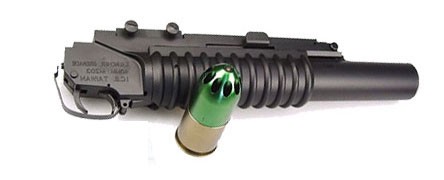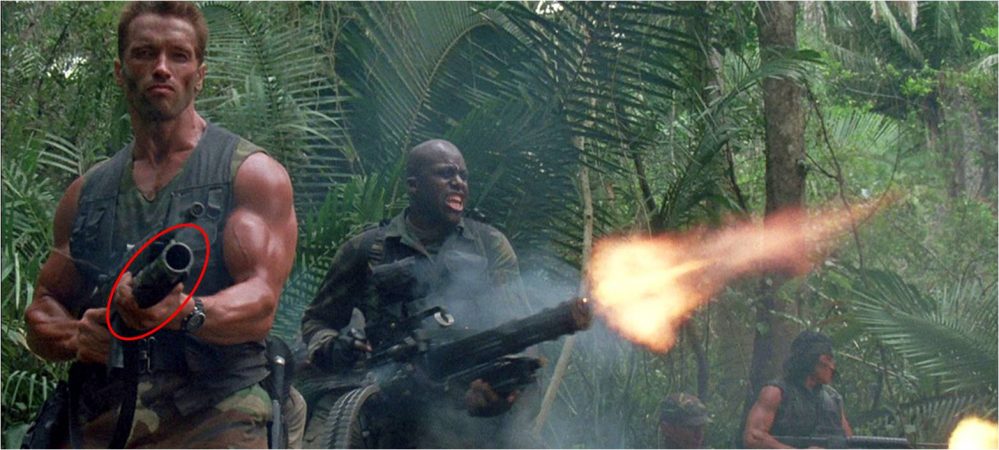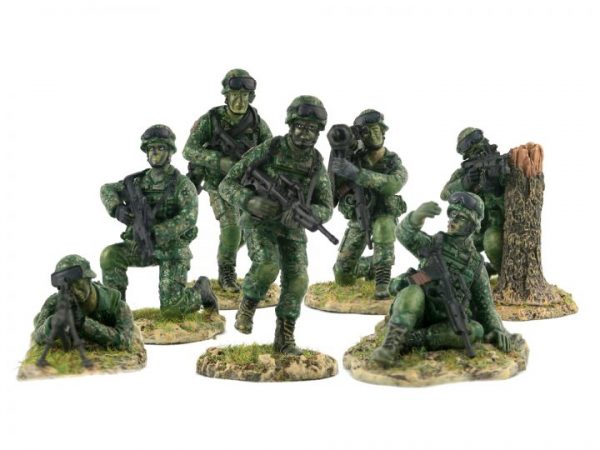“The mission of MINDEF and the Singapore Armed Forces is to enhance Singapore’s peace and security through deterrence and diplomacy,
and should these fail, to secure a swift and decisive victory over the aggressor.”
– Mission Statement of The Singapore Army
How is a swift and decisive victory secured? No doubt, it is with the capabilities of competent soldiers. However, the firepower that they employ matters a great deal as well.
In the Singapore Armed Forces (SAF), a typical infantry section consists of seven soldiers who operate the following weapons:
Two SAR 21 Assault Rifle with M203 Grenade Launcher
Two SAR 21 Assault Rifles
One SAR 21 with Sharpshooter scope
Two MATADOR Light Anti-Tank Weapons (HEAT Warheads)
Two Ultimax 100 Mk II/III/IV Light Machine Guns
Here’s a quick introduction to these weapons, with accompanying videos to demonstrate each weapon in action. Be sure to turn up your volume!
Singapore Assault Rifle (SAR) 21
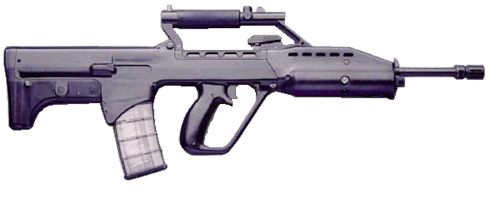
Picture Source
We kick things off with the main infantry weapon currently used by Singapore’s NS men.
Those of you men currently above the age of 30 would have served your NS firing the M16 Assault Rifle. However, after almost three decades of being the longest-serving standard assault rifle, the M16 was replaced by the SAR 21 in 1999. At that time, the SAR 21 was the latest development of Singapore Technologies (ST) Kinetics (then known as the Singapore’s Chartered Industries company), and was touted as one of the world’s most advanced assault rifles. It boasted several technological advancements and improvements that made it accurate, reliable and comfortable to use.
Bullpup Design for Better Handling
The most noticeable feature of the SAR 21 is its “bullpup” design where the action is located behind its trigger group. This design permits a shorter overall weapon for a given barrel length, thus maintaining the advantages of a longer barrel in muzzle velocity and accuracy, while improving maneuverability and reducing weight.
The bullpup design makes the SAR 21’s overall size about 20% shorter than the M16, therefore making it better-suited to the smaller Asian stature, and easier to maneuver in tight spaces such as in vehicles and buildings.
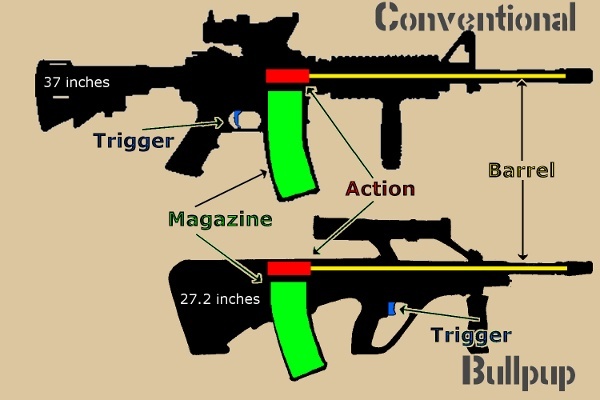 Picture Source
Picture Source
Integrated 1.5x Optical Scope and Laser Aiming Device for Greater Accuracy
The SAR 21’S built-in aiming scope with 1.5 magnification makes it possible to engage the target quickly, as the user would be able to detect and hit targets rapidly and accurately.
To further enhance target engagement, the SAR 21 has a Laser Aiming Device (LAD), which enables its user to fire quickly without aiming through the scope. This feature makes the weapon highly effective for night combat and close combat in urban settings.
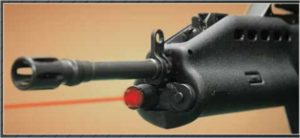 SAR 21 Laser Aiming Device (Picture Source)
SAR 21 Laser Aiming Device (Picture Source)
Low Recoil for Greater Control
The SAR 21 has a low recoil (the kick-back felt when a round is fired), which allows the firer to have better control over the weapon, and also to recover faster between successive shots. This is a critical element for combat readiness.
Customisations for Greater Versatility
As the SAR 21 was manufactured in Singapore, it was possible to construct it with a modular design to accommodate customisations. For example, the 40mm M203 Grenade Launcher can be attached to add grenade-launch capability to the assault rifle, thereby expanding its reach and firepower.
The SAR 21 also has a Modular Mounting System Carbine, which allows a wide variety of add-on tactical accessories to be mounted to its 2 sets of Picatinny Rails.
 SAR 21 Modular Mounting System & Variants (Picture Source)
SAR 21 Modular Mounting System & Variants (Picture Source)
Specifications of the SAR 21
- Length : 805mm
- Calibre : 5.56 x 45mm
- Barrel Length : 508mm
- Sighting system : 1.5x Optical Scope Laser Aiming Device
- Effective Range : 460m
- Weight : 3.98kg
- Rate of fire : 450 – 650 rounds/min
- Feed Device : 30 rounds Plastic Box Magazine
Watch the SAR 21 in action:
Full Video Source
M203 Grenade Launcher
Earlier we mentioned how the M203 Grenade Launcher can be attached to the SAR 21 as a separate module under the rifle barrel. The M203 is in fact very versatile and compatible with many rifle models.
Origins and Purpose
It was originally developed in the United States during the late 1960s and was first employed in the Vietnam War. It replaced the M79 break-action standalone grenade launcher, in order to enable soldiers to also carry a rifle and easily switch between the two.
The M203 Grenade Launcher is designed for close fire support, and is effective at breaking through windows and blowing up doors, and damaging unarmoured vehicles (such as trucks and cars). It can also be used as a weapon for crowd control when equipped with the M651 Tactical CS (tear gas) grenade.
According to the U.S. Army Field Manual, 8 different rounds were developed for the M203, each serving a different purpose and combat situation.
Some Movie Trivia
Given its long history and versatility with many assault rifles, the M203 has been featured in countless action blockbusters such as Rambo, Predator and Aliens, just to name a few.
Arnie approves of the M203 Grenade Launcher
Specifications of the M203 Grenade Launcher
- Length : 380mm
- Cartridge: 40×46mm Single Round
- Barrel Length : 305mm
- Sighting system : Quadrant sight or ladder sight on rifle
- Effective Range : 150m
- Maximum Range: 400m
- Weight : 1.36kg (unloaded)
- Rate of fire : 5 to 7 rounds/min
Watch the M203 in Action:
Full Video Source
Ultimax 100 Squad Automatic Weapon (SAW)
 Picture Source
Picture Source
In the SAF, an infantry section of seven men would have two Section Automatic Weapon (SAW) Gunners operating the Ultimax 100. Using this light machine gun, they would dish out suppressive fire to pin the enemy down whilst the rest of his section moved into a flanking maneuver.
The Ultimax 100’s Less-Known Designer
Although the latest version of the Ultimax 100 (Mark 8) was unveiled in 2017, this light machine gun was actually first designed decades ago in the late 1970s. Most of us know that the Ultimax 100 was developed by ST Kinetics. What is not as widely-known, is the fact that it was designed by an American by the name of James Sullivan, when he was employed by ST Kinetics in the small arms design team. Incidentally, James Sullivan also co-designed the M16 Assault Rifle, which, as many of us know, came to be the standard rifle used by all Singaporean males who served their NS from the 1970s all the way to the 1990s.
For those of you who want to go in-depth to the inspiration behind the design of the Ultimax 100, we highly encourage you to read this interview with the man himself.
The Best Light Machine Gun in History
After various upgrades and versions, the latest Ultimax 100 Mark 8 has been positively reviewed by many small arms experts around the world and considered to be the best-ever-made. This is no surprise, given its patented features that dramatically increase its firepower and accuracy. The Ultimax 100 also stands as one of the lightest machine guns in the world that fires from a drum.
Low Recoil for Ease of Control
The Ultimax 100 has a considerably low recoil for a light machine gun, and this is thanks to its patented “constant recoil” system. This feature is extremely important in machine guns, as it greatly boosts accuracy during automatic fire. In fact, it is not uncommon for SAW gunners to qualify for the “marksman” badge at the firing range!
Specifications of the Ultimax 100
- Length : 935 / 1025mm
- Calibre: 5.56 × 45mm
- Barrel Length : 508mm / 457mm / 330mm
- Operation : Gas Operation, Open Bolt, Short Stroke Piston & Gas Adjustments
- Effective Range : 800m (SS109) / 460m (M193)
- Weight : 5kg
- Rate of fire : 400-600 rounds/min
- Feed Device : Drum magazine 100 rounds or box magazine 30 rounds
Watch the Ultimax 100 in Action (note the extremely low recoil):
Full Video Source
MATADOR
There is nothing more frightening to an infantry trooper than having to face a tank or armoured vehicle and feeling completely overpowered with conventional light firearms that are unable to penetrate the vehicle’s armour. Thankfully every section in the SAF is loaded up with two soldiers who each heave an anti-tank weapon known as the MATADOR!
The MATADOR, which stands for Man-portable Anti-Tank, Anti-DOoR, is a 90-millimetre (3.5 in) weapon originated in Germany. As its name suggests, it is designed to have enough firepower to inflict damage on armoured vehicles, doors and walls, yet be mobile enough to be carried by a soldier.
The MATADOR’s Origins
The MATADOR was developed in the late 1990’s by Dynamit Nobel, at the request of the SAF. It was meant to replace the Armbrust, which was a Light Anti Tank Weapon. The original MATADOR was developed in collaboration with the Singapore Defence Science & Technology Agency, whilst later specialized versions were developed together with the Israeli company Rafael in the early 2000’s.
Big Firepower
The MATADOR has both anti-armour and anti-brickwall capabilities that are suitable for operating in confined spaces. With its enhanced penetration capabilities, it is capable of defeating most known Armoured Personnel Carrier and Light Tanks in the world.
In order to perform this task, the MATADOR has a dual-capability warhead which fires a multi-mode warhead in two different modes – the HEAT and the HESH mode.
In HEAT mode, it is used against armored targets and will pierce Rolled Homogeneous Armour (RHA) up to 500mm thick.
Whilst in HESH mode, the MATADOR can penetrate concrete and create a 45 cm diameter opening, providing soldiers with a new point of entry. This was used to great effect by the Israel Defence Forces (IDF) soldiers during Operation Cast Lead in the Gaza Strip in 2009, which took place in confined urban spaces – thanks to the MATADOR’s small back blast, IDF troops were able to use it to create entry points in tight spaces.
Specifications of the MATADOR
- Weight: 8.9 kg (19 lb 10 oz)
- Length: 1 m (3 ft 3 in)
- Caliber: 90 mm (3.5 in)
- Muzzle velocity: 250 m/s (820 ft/s)
- Effective firing range: 500 m (1,600 ft)
- Feed system: Disposable
- Sights: Integral optical sights or Night Vision Device on a Picatinny rail
Watch the MATADOR in Action:
Full Video Source
FN MAG / General Purpose Machine Gun
The FN MAG is short for Fabrique Nationale MAG, and MAG stands for “Mitrailleuse d’Appui General”, which translates to “General Purpose Machine Gun”, or GPMG. It is one of the most widespread and effective machine guns in the world, and is adopted by the SAF in an infantry platoon to provide mobile fire support. The FN MAG is more commonly known amongst NS men as the GPMG.
It’s Nothing Like in the Movies
Typically, SAF soldiers first encounter the GPMG during Basic Military Training (BMT), when they go through the Battle Inoculation Course (BIC) – a simulation of a battlefield during wartime. In that Course, trainees have to overcome a myriad of obstacles by leopard crawling and back crawling with live rounds whizzing above them. Consequently, these live rounds are fired from the FN MAG mounted on an overhead platform.
Anyone who has personally experienced a GPMG firing live rounds will realise that the sound effects in most war movies do not do justice to the weapon. This is because machine guns have a distinct and deep fearsome bark, so the mere sound of a GPMG firing actually provides a psychological terror effect, not to mention the stream of bullets erupting from its gun barrel!
A Brief History of the FN MAG’s Design
Development of the FN MAG started in the 1950s, when Fabrique Nationale, a Belgian arms company, assigned their top designer, Ernest Vervier, to develop a general purpose machine gun along the same lines as the German MG-42 that was commonly used in World War 2.
Several design attributes of the MG-42 were hence borrowed for the design of the FN MAG. This included its trigger mechanisms, quick-change barrel, and spring-loaded dust cover. However, much of the FN MAG was derived from the basic design formula of the venerable Browning Model 1918 BAR.
In fact, Vervier created most of the MAG by simply inverting the BAR’s receiver, so that it could be belt-fed from above rather than magazine-fed from below. The MAG’s development was complete by 1957, and subsequently adopted by the Belgian military in 1958. It has since been employed by many military forces around the world.
Specifications of the FN MAG
- Weight: 11.79kg
- Length: 1,263 mm
- Barrel length: 630 mm
- Width: 118.7 mm
- Height: 263 mm
- Cartridge: 7.62×51mm NATO
- Action: Gas-operated, open bolt
- Rate of fire: 650–1,000 rounds/min
- Muzzle velocity: 840 m/s (2,756 ft/s)
- Effective firing range: 800 m
- Maximum firing range: 1,800 m from tripod
Watch the FN MAG in Action:
Full Video Source
That’s it, folks! Perhaps our next installment will be on the M-16 Assault Rifle – a tribute to all you Baby Boomers and Gen-Ys!
*Cover pics by MINDEF
Are you “triggered” by the firepower of these weapons? Our Section in Assault series of collectible figurines play out an actual section of SAF Soldiers equipped with the weapons featured here. Check them out at our online store now!


